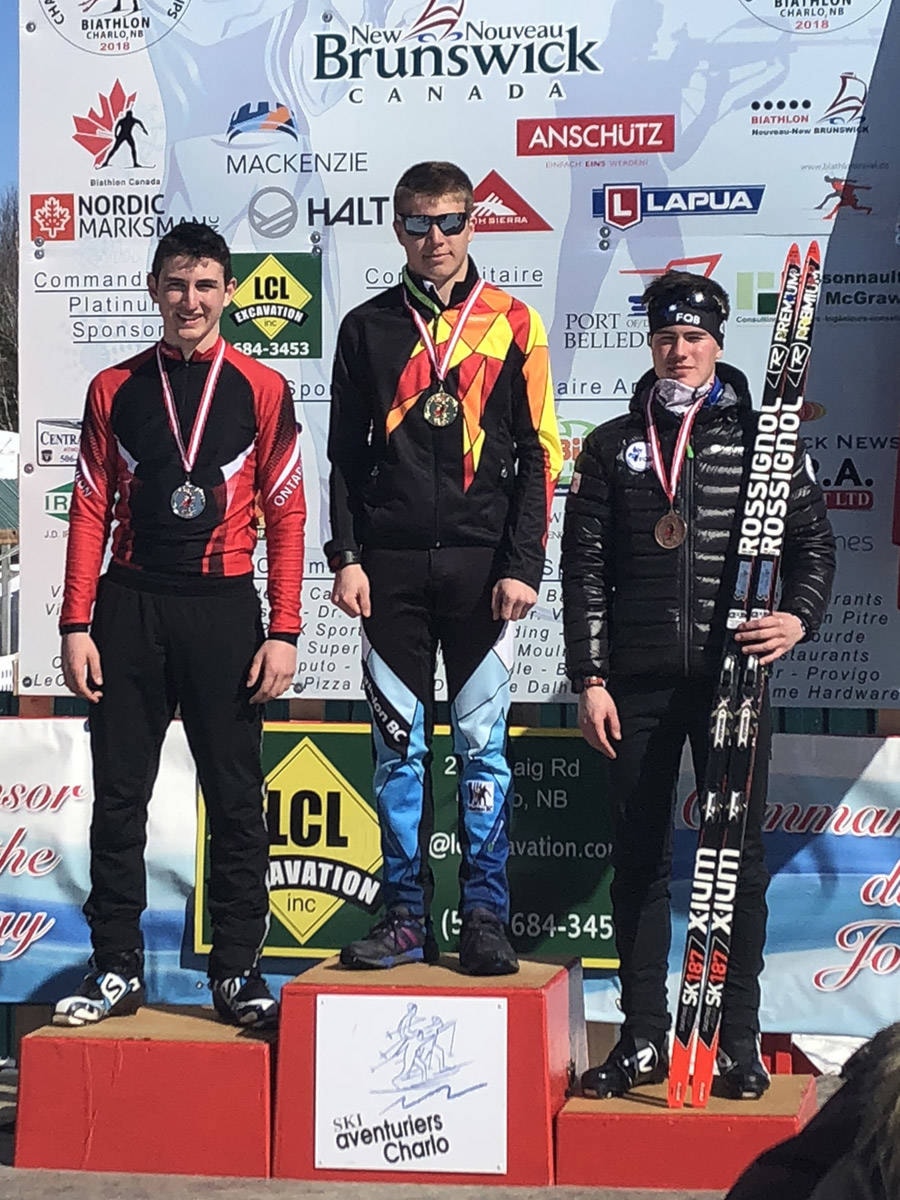Two biathletes from �������� Lake won top titles at national championships, which took place in New Brunswick from March 20 to 25. Cole Bender took home gold in several events, while Emily Dickson won gold, silver and bronze.
First place for Bender
Bender dominated the senior boys’ category — ages 15 to 16 — winning gold in four competitions. In the 6 km sprint, he finished more than one minute ahead of his closest rival, Ontario’s Zachary Connelly. And he displayed perfect marksmanship in the event, which involves stopping twice at firing ranges.
The next day, in the 7.5 km pursuit, he missed two shots while standing but still managed to clock in more than one minute and 30 seconds ahead of Connelly, who once again won silver.
On Saturday, March 24, Bender’s three-person team took home gold in the mixed boys’ and girls’ 4.5 km relay, finishing one minute and 35 seconds ahead of their closest rival, a team from Quebec.
Bender capped off the week the next day with a gold medal in 7.5 km individual competition, shooting flawlessly and ending the match two minutes and 50 seconds ahead of Zachary Demers.
Dickson owns the podium
Dickson made it to the top of the podium despite fighting a cold during the week of the competition. Since these are the last races of the season, she said she’d tough it out. “I travelled this far to race,” she said. “I’m skiing better than I thought I would, considering the circumstances.”
Dickson — the 20-year-old biathlete who hails from �������� Lake and now lives and trains in Canmore, Alta. — spoke to the Lakes District �������� from her hotel in Charlo, N.B. “It’s fun to see this side of the country,” she said of New Brunswick.
Earlier that day, Dickson had finished in third place in the junior women’s 10 km pursuit. During the event, which involves four shooting sessions, she missed two targets from the prone position and three while standing.
Her final time was less than three minutes behind the gold medal winner, Alberta’s Megan Bankes, and just 20 seconds behind the silver medalist, Nadia Moser of the Yukon.
On Wednesday, March 21 — in skiing conditions that Dickson described as “ideal” — she won silver in the 7.5 km sprint. In that competition, she didn’t miss a single target, and came in less than 12 seconds behind Bankes.
Later that week, her team finished third in the junior men’s and women’s 6 km relay, six minutes and 15 seconds behind the gold medal-winning team from Alberta, and two minutes and 12 seconds behind the second-place team from Quebec.
Dickson finished the week with gold, coming in three minutes and 48 seconds ahead of Zoe Pekos in the junior women’s 10 km mass start event, missing just two targets while standing.
Among the Olympians
The competition included biathletes from Team Canada, fresh from the Olympic Games in PyeongChang, Korea. Since those more senior athletes cover the same distances as junior women athletes like Dickson, she was interested in comparing her performance directly to theirs.
The day that she won the silver medal in the junior women’s 7.5 km sprint, her time was just a fraction of a second behind most of the Olympic competitors. She even slightly outpaced one of them. “I was right in there and quite competitive with the national team,” she said. “That was pretty cool to see.”
World stage
Dickson’s success at the Canadian Championships comes on the heels of Junior World Championships in Otepää, Estonia, where her results included placing 26th out of 59 in the junior women’s 10 km pursuit. It was her fifth time in the World Juniors, and her second time in the town of Otepää.
About the biathlon
Competitors traverse a cross-country course while carrying a .22-calibre rife, stopping at firing ranges and shooting from standing or prone positions at a series of targets posted 50 metres away.
There are six types of biathlon events under the International Biathlon Union, the world governing body of the sport: individual, relay, pursuit, sprint, team and mass start.
In the individual event, every missed shot adds a minute to the biathlete’s final time. In the other events, competitors must complete a penalty loop for each missed shot.
Competitors start simultaneously for all events except the pursuit and the individual, in which they start at intervals. In the pursuit, that interval is based on results from the previous race.
The biathlon can be traced back to Scandinavia, where the Norse god Ull was worshipped as the ski god and the god of hunting. His wife, Skadi, was also revered as a great hunter and skiier.
By the early 1700s, military units fighting in the region combined skiiing and marksmanship, and the first recorded biathlon competition occurred in 1767.
The women’s biathlon became an Olympic sport in 1992, and a Canadian — Myriam Bédard — is the only non-European to have won an Olympic title.
Source: Encyclopedia Britannica



